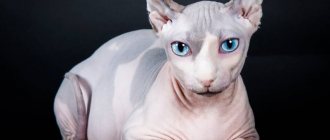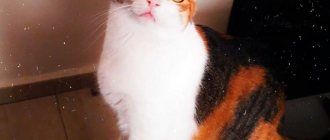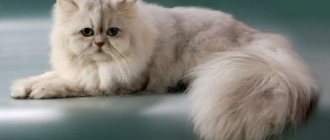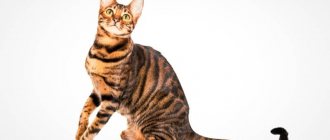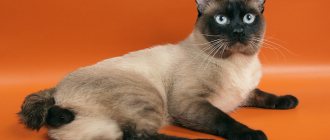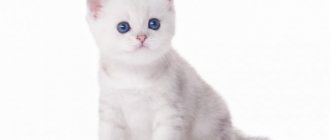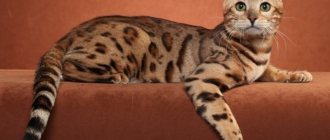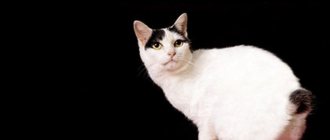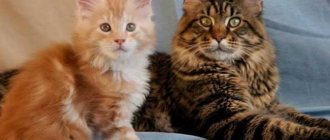British cat, golden chinchilla color.
History of the unique color
The first golden chinchilla kittens were born in a litter of silver chinchilla Persian cats. Breeders were interested in the unusual coloring, but were unable to find the gene responsible for it.
This is interesting. Silver chinchillas have a white coat, and the darkened ends of the hair create the effect of a thrown veil.
Experts decided that the golden pigment appears as a result of the interaction of a whole group of genes. And then the breeders began targeted selection to consolidate the desired trait in the genotype of the animals.
British golden chinchilla cats were bred in the UK. They were created by crossing a Golden Persian and a Smoky Briton. As a result of systematic work, a cat named Silver Lambkin appeared in 1889, who was recognized as the ancestor of this variety.
A little later, Scottish cats began to be crossed with Golden Persians and the British. Animals of this color looked very impressive.
This is interesting. Golden chinchilla cats are often called royal or royal.
Story
The history of Chinchillas begins in 1882, when, as a result of crossing British and Persian cats, offspring with an unusual coat color appeared. The owners were delighted and without hesitation decided to breed a new species with a color reminiscent of chinchillas. In 1889, a kitten was born who was given the nickname Silver Lambkin. He became the founder of the variety.
In addition to the silver color, the breeders wanted to fix the green color of the iris. For a long time they strived for this, diluting the blood of Chinchillas with other species. It is believed that not only Persians, but also Orientals, Burmese and other cats participated in the breeding of the breed.
Golden cat
Unfortunately, such mixing gave a negative result. The green color of the eyes was not fixed, and the kittens lost that very unique color of the Chinchilla.
Therefore, felinologists stopped experimenting, continuing only with intrabreed crossing. From time to time they added the blood of Persian cats, but no more.
In the end, the breeders took silver chinchillas as a basis and continued working on colors. They managed to bring out several shades at once: shaded gold and silver. Additionally, another variety of the breed arose - longhaired.
Princess Victoria liked unusual pets. Having settled them in her palace, she encouraged cat lovers to engage in a new subspecies. This is how breeding arose not only in Great Britain, but also in other European countries.
Origin
The breed was bred in Great Britain when, in the 70s of the last century, English breeders decided to cross Persian and British Shorthair cats. The idea was crowned with success - the result of the work done was unusually beautiful animals with luxurious fur and a squat, powerful physique. Soon all the necessary documentation describing the characteristics of the breed was fully approved. In 1980, the first official representative of the British chinchilla named Silver Lambkin was presented to the public, who later became the champion of many international exhibitions.
Where and how much to buy a British breed kitten
- In Moscow, British shorthair kittens can be bought at the SunRay nursery. On the nursery website https://www.sunny-cat.ru/ you can see photos of available kittens, book a kitten and find out any other information.
- In Minsk, British kittens are offered by the Krembel nursery creambel.com
- In Kyiv you can buy a British kitten in the cattery “Devinore*UA” www.devinor.com.ua
- Complete list of British Shorthair catteries (in Ukraine and Russia).
The price of British Shorthair kittens may depend on the class of the pet, coat color, prestige of the nursery, and city. You can buy a British kitten “hands-on” for 1,000 rubles , but in a nursery it will be more expensive – from 2,500 to 60,000 rubles . Please note that you can be sure that your pet is purebred only by purchasing it from a certified nursery.
Video
Genetics of color
A polygenic complex is responsible for the golden chinchilla color, providing a warm shade of the undercoat and a lightened background color:
- melanin inhibitor – absorbs hair pigment, starting from the hair root;
- agouti and tabby (tabby) - forms a pattern;
- erizer – gene eraser, gives the undercoat a warm shade.
The golden chinchilla color includes several varieties depending on the color of the hair tips:
- black;
- chocolate;
- lilac;
- faun (fawn);
- cinnamon (cinnamon);
- blue.
The golden color is a recessive trait in relation to the silver color. Kittens of this color can be obtained in the following cases:
- both manufacturers have a golden color;
- parents are silver chinchillas, but are carriers of the golden gene;
- one producer is golden, the second is silver, but his genotype contains genes for goldenness.
Recognized colors of chinchilla cats
Silver chinchilla.
Considered a classic color. Ticking includes white and black colors. In this case, only the very tip (one eighth of the entire length) of the hair is colored black. This creates a spectacular smoky shade.
Silver shaded.
The black ticking is enhanced on the tail and paws. The belly, chest and chin are predominantly white.
Golden chinchilla.
A color developed relatively recently. Light peach and black tints at the tips of the coat.
What is the color of a chinchilla, and where do such cats come from?
Some people, when they hear about a chinchilla cat, think that this is such a breed. Not really. Fur, reminiscent of a rodent's coat, can be characteristic of representatives of several breeds - British, Scottish, Persian.
© shutterstock
The first chinchilla-colored kitten was born at the end of the nineteenth century in the British Isles. He was born in a nursery, and immediately found himself in the center of everyone's attention. His fur looked very unusual and interesting - light at the roots and in the middle, and dark at the tips.
People liked this color so much that they decided to deliberately breed chinchilla cats. This took many years, and today we see the fruits of the painstaking work of breeders of the 19th and 20th centuries.
As noted above, the chinchilla color is compared to the color of the fur coat of chinchilla rodents, which also seems to be covered with a haze. In addition, the fur is just as thick, elastic and very pleasant to the touch. There are two types of chinchillas. This :
- Tipped , in which the standard is the light part of the coat, occupying 7/8 of the entire length of the hair, and only the tip is black.
- Shaded suggests 2/3 or a little less of the light part, and the rest is dark.
The chinchilla cat was obtained by crossing Persian breeds and British smoky. The light color of the fur of the former was shaded at the tips due to the genes of the latter. To breed chinchillas, they worked with cats whose fur had a pattern (the genetic background of agouti). It was eroded in a special way, each time producing an increasingly more advanced generation.
Characteristics and color features
Regardless of the breed, chinchilla cats should have hair with a smooth color transition from soft pink to dark at the tips. The undercoat can be of different shades: from light peach to red. There should be no dull or grayish areas on the body.
The color is considered chinchilla if the dark tip occupies 1/8 of the length of the hair. If 1/3 is painted, the color is called shaded, if 1/2 is called golden tabby.
In chinchillas, the pigmentation of the iris is usually green or bluish-green. There is a dark brown or black edging on the eyelids, lips and nose. The lobe is colored pink, the paw pads are black or brown.
Information about the breed and color of the cat is indicated in the pedigree. Special designations are used for this.
Breed:
- BRI - British;
- PER – Persian;
- SFL – Scots Fold Shorthair;
- SFS – long-haired Scots Fold;
- SCS – Scots with erect ears, shorthair;
- SCL – long-haired, erect-eared Scotsman.
Color:
- y – golden;
- a – blue;
- b – chocolate;
- c – lilac;
- n – black;
- o– cinnamon;
- q – faun.
Picture code:
- 11 – shaded;
- 12 – chinchilla;
- 21 – linx (tabby pattern on the face and paws);
- 22 – marble;
- 23 – brindle;
- 24 – spotted;
- 25 – ticked (each hair has more than two dark zones);
- 33 – point (reminiscent of the Siamese color).
At the end they put numbers indicating eye color:
- 64 – green;
- 61 – blue;
- 62 – yellow.
For example, a Scottish fold short-haired chinchilla of golden color with black tips of hairs and green eyes would be written as follows: SFLny 12 64.
History of the breed
The story of Chinchilla begins in the 80s of the 19th century with a cat named Chinnie. Researchers suggest that she was darker than modern representatives of this breed, and her hair was only 1/3 colored. They found a cat of a suitable color for her, from mating with which they managed to get two litters of silver kittens. According to the recollections of contemporaries, two cats were especially good, which were often exhibited, but they had no offspring. The cat Beauty continued the line of chinchillas. Her kitten became the first representative of the Chinchilla breed.
Back in the 20s of the 20th century, this breed was very small in number, and crossing was carried out with other purebred cats of smoky, blue color and silver tabbies. Only by the mid-30s did enough chinchillas appear to continue working on the color. Thus, the Chinchilla color became the first color that was deliberately created and fixed by breeders.
Golden Chinchilla Standards
For the first time, the golden chinchilla color was included in the standard of Persian cats. Now it is found in many breeds for which the silver chinchilla color is recognized.
Preference is given to cats with a uniform golden undercoat without a gray area at the roots. When the color first appeared, such animals were still used for breeding, but now they are increasingly not allowed to breed.
There is no single standard regulating the color of the golden chinchilla. Experts evaluate animals in accordance with documents approved for a specific breed by the World Cat Federation:
- British cats are stocky, massive and muscular. The head is round, with a wide skull and pronounced cheeks. The ears are small, set wide, and the tips are slightly rounded. The tail is thick and curves upward. The coat is raised, dense and short.
- Scottish - divided into fold-eared (Scottish fold) and straight-eared (straight). The first ones have small ears, the tips hanging forward. The limbs are short and thick. Straights have erect ears and can be small or medium in size. The limbs are slightly longer and lighter.
- Persian - distinguished by rectangular body lines. Legs are strong and short. The head is large, the forehead is sloping (other chinchillas have a rounded forehead).
Golden chinchillas have ears covered with dense and short fur. The eyes are very large and expressive.
British
British chinchillas are usually smaller. They ripen late - full formation of the exterior is completed by 3 years.
The wool has a soft and silky texture. There are 2 varieties: British shorthair and longhaired chinchillas. The latter have elongated fur, which is inherited from Persian cats.
The most common are golden chinchillas with green eyes, but there are cats with blue and yellowish irises.
Nutrition
The diet of the golden chinchilla breed has its own characteristics. The cat is prone to obesity because it leads a sedentary lifestyle. Low-calorie food must be selected. You can purchase it ready-made, with complexes of vitamins and minerals. If a cat eats natural products, then it is forbidden to give it fried and fatty foods.
Fish and meat should be chosen from low-fat varieties. Preference is given to rabbit, offal, and poultry meat. The diet should periodically include liver, heart (can be chicken) and kidneys. They are served to animals only in boiled form. The cat loves fermented milk products, but they can only be given in small quantities. Gradually it is allowed to add grains and vegetable oil to food.
The golden chinchilla should eat three times a day. For the growth of beautiful fur, vitamin supplements are added to the food. However, you need to choose them without biotin. It negatively affects the coat.
How to organize food for a British chinchilla
The British diet should be varied. It is advisable not to alternate between store-bought food and homemade food, but to choose one type of food. Store-bought food must be selected taking into account the characteristics and characteristics of the pet (weight, size, health problems). It is best to contact your veterinarian with this question.
Chinchillas accept chicken, turkey and rabbit well.
Cats eat both raw and cooked meat. The main condition is to chop finely. A Briton can only be pampered with fish eight times a month. The same dosage applies to dairy products (kefirs, yoghurts and low-fat cottage cheese). Among the cat's favorite vegetables are carrots and cabbage; she also prefers buckwheat porridge and bran.
British chinchillas need to be fed 2-3 times a day.
To keep the coat in perfect condition, you need to buy cat vitamins without biotin (it shortens the coat). The most effective way to improve coat is to give kitten food. However, this is only permissible before competitions.
It is necessary to dilute their natures with products, among which preference is given:
- boiled beef or chicken;
- ocean fish;
- stewed vegetables (they are mixed with meat);
- quail eggs;
- milk and products made from it.
Scottish
The Scottish chinchilla cat has the same color as the British one. She has a plush coat, a dense undercoat of a warm shade, dark lining of the eyelids, lips and nose, and brown paw pads.
The eyes are most often green, but can also be blue. These animals have soft, rounded body shapes, which provide developed muscles and thick hair.
Description and breed standard
Chinchillas today come in a wide variety of colors, from cream and white shades to almost brown. Some of them are not recognized as a standard and, nevertheless, they find their fans. These include: chinchilla cinnamon, tortoiseshell cinnamon and creamy fawn tortoiseshell.
As the CFA characteristics say, the chinchilla cat breed, regardless of color, has the following immutable standard:
- The heads of these cute creatures are round, with a convex skull, a pronounced jaw and a small chin. Wide oval eyes of a green-blue hue, very expressive, thanks to the harmonious dark edging, complement the picture of a pretty face that evokes sincere emotions.
- The ears are located low and wide relative to each other, and have rounded ends.
- Chinchillas have snub-nosed noses, mostly pink, but can be darker, even red-brown. The shade of the nose depends on the color of the animal. The nose, along with the eyes, has a dark edging.
- A chinchilla cat can reach a weight of 7 kg, a female – up to 5 kg. This is quite a lot of weight, yet their appearance is harmonious, they look soft and “airy”, gracefully flaunting their fur playing with the finest transitions of a ticked shade.
- The tail of this pet is short, as are its paws. Plus, they are visually “shortened” by the abundance of thick, long hair. The dark pads of the paws, visible between the plump toes, look touching.
- The straight back and wide chest indicate the breed is a true British aristocracy.
Description of the breed
At the end of the 19th century, the first kitten was bred with plush gray fur. The work was assessed as experimental. Then additional research and crossings began, as a result of which the official ancestor of the British chinchilla Silver Lambkin appeared.
Silver Lambkin
Silver participated in numerous exhibitions, where he was a repeated winner and prize-winner. The cat lived for 17 years.
Afterwards, work was carried out on the color of the animals' eyes. Breeders tried to achieve a beautiful emerald color; mixing led to the fact that the fur became worse. Initially, only light gray colors were recognized, which were called silver.
After the ideal silver cat was bred, breeders began to develop other colors. Later, golden chinchillas appeared. At the end of the 20th century, the species earned international recognition and was included in the official list of breeds with its own standard.
Appearance
The British Chinchilla standard corresponds to the characteristics of the British Shorthair cat. The main difference is the wool.
Representatives of the breed have a large body with a wide sternum, a straight back, and well-developed hips. The muscle corset is strong.
Breed standard:
- a large rounded head with a wide forehead and a neat rounded muzzle with wide cheekbones and pronounced round cheeks;
- the nose is wide, short and straight, the nose mirror is pink or brick colored;
- small rounded ears at the ends are spaced widely apart;
- the neck is short, thick and muscular;
- the eyes are large and round, set shallowly and not very far apart, the color is rich emerald green, but there are blue-eyed and yellow-eyed individuals;
- well-developed muscular limbs are proportional, but short, making cats appear squat;
- the paws are round, thick and large, with tufts of hair between the toes;
- the tail is not very long, thick, with a rounded tip;
- weight: male - 5-8 kg, female - 3-4 kg (castrated or sterilized individuals can reach 10-12 kg).
The coat should be dense and dense, the undercoat should be well developed.
Character of the breed
Representatives of the breed do not like to obey. They can become attached to the owner, but they always put themselves in the same place with him. The animal is calm, prefers to observe the situation from the side, and intervenes only if necessary.
Pets are quite capricious, do not like excessive affection, and prefer to spend time alone. They are easy to train and quickly get used to the tray. The British almost never play pranks in the apartment and do not damage furniture or wallpaper.
Cats are characterized by slowness, thoroughness, and patience. The animal will not ask for food at the wrong time and wake up the owner unnecessarily.
Colors
There are three main colors of the breed.
Silver or silver is considered classic and is most common. The ground color is white, and the undercoat is black at the tips. Darkening occurs on the sides, back, and tail. The muzzle (eyes and nose) is outlined with a thin black outline, the paw pads are dark.
The golden color is distinguished by the presence of a golden-colored undercoat. The color is even, without spots, all color transitions are smooth. Shading occurs on the tail and back. The belly and chest are distinguished by a light apricot hue.
The shaded color differs from silver in having a darker undercoat and the presence of large dark spots. There are dark stripes on the paws and tail; there are no pronounced transitions on the body.
Experts also distinguish ticked colors (merle). Chinchillas can have this color mainly in golden color. Such individuals have bright blue or blue eyes, and their character is more impulsive.
Breed health
Cats have strong immunity and rarely get sick; if they are improperly bred or crossed with closely related individuals, genetic abnormalities appear.
The most common diseases:
- retinal atrophy;
- polycystic kidney disease;
- thickening of the wall of the cardiac ventricle.
In the presence of genetic abnormalities and hereditary diseases, individuals are excluded from breeding and are considered defective.
Description of the British chinchilla
A British chinchilla cat can be silver, shaded silver (smoky) and gold. Recently, chinchillas with color-point markings have begun to appear.
Otherwise, this is a typical British Shorthair cat with well-developed muscles. A wide neck, flat back, developed chest, hips are complemented by large powerful legs, a thick tail, rounded to the tip.
Appearance
Regardless of the color of the “haze” on a cat’s fur, in accordance with approved standards, the color of each hair should not be more than 1/8 black. The eyes of these animals are emerald green, although silver cats may have yellow eyes. According to their genotype, these cats should be black, so even animals with a light coat usually have black pads on their paws, as well as dark lining around the eyes and nose. The eyes of these animals are very expressive and have a round shape. The coat is thick, with a well-developed undercoat.
Chinchilla color standards for British cats.
The British Golden Chinchilla is only partly golden in color. The back, tail and sides have a darker shade, the chin, chest and belly are apricot-colored. In total, a cat can be of three colors:
- Silvery: the spine is white, the tips of the hairs are colored black. The undercoat is white. The tail, sides and back are the darkest areas on the skin. The belly and chest remain white, creating the impression of a light translucent veil.
- Golden: the awn is apricot in color, the tips of the hairs are colored black or blue. The paw pads, eye rims, and nose may be black or blue-gray, depending on the color of the ticked tips of the coat. In some places, the color of a British Golden Chinchilla kitten can be a rich red color.
- Silver with shading: darker than usual silver due to coloring of the guard hair not by 1/8, but by 1/3 of the length. The undercoat is white, there is no pattern on the coat, except for stripes on the tail and paws.
Sexual dimorphism is pronounced. Males are distinguished by large cheekbones and dense cheeks, females have a thinner constitution.
British chinchilla cats are noticeably smaller than male cats.
Character
The habits of these animals can be called truly English.
They are calm, always carry themselves with dignity, have good manners. From an early age they are accustomed to the litter box without problems, and do not have the habit of waking up their owners. These cats build excellent relationships with everyone who lives with them under the same roof. Children do not irritate British chinchillas too much, even if they sometimes bother them with intrusive games - then the animal simply goes elsewhere. Due to its natural independence, the cat does not tolerate encroachments on its freedom. One of their characteristic traits can also be called stubbornness. Bites and scratches are not the method of communication that these cats choose for themselves.
Persian
Persian chinchillas are slightly smaller than their counterparts. They are harmoniously built, distinguished by fine bones and elegance, but at the same time strong and resilient. In the USA, larger cats are bred, which are very similar in size and build to standard Persians.
The coat of Persian golden chinchillas is long and dense. The fur shimmers beautifully in the light. The cat may have emerald or bluish eyes with a brown rim. The soft pink nose is small and neat.
Character and behavior of elite pets
Chinchillas are considered the aristocrats of the cat family. They are distinguished by noble manners, a sharp mind and excellent memory.
The characteristics of golden chinchilla cats are determined by the breed:
- British are balanced and reasonable animals. They are characterized by patience, silence, and lack of desire to cause mischief. Owners note that the Golden Briton is more people-oriented. He needs the attention of his owner, but does not suffer from excessive intrusiveness. This is a good companion who loves children, follows the rules of living together in an apartment, and travels with pleasure.
- Scottish cats are capricious and curious pets that often meow and are excessively intrusive. But at the same time they are playful and friendly. They tolerate loneliness quite well if they have a variety of toys at their disposal.
- The Persian is an obedient cat. She can be overly touchy, but quickly forgets troubles. Quite lazy, but during play or hunting she is very active. Although outwardly unperturbed, she may suddenly jump onto a hot stove or perform some other unexpected action.
Each animal has individual character traits. Therefore, the habits and behavior of pets may differ slightly from the description given.
Character and temperament of cats with chinchilla color
These beautiful, majestic animals have a calm disposition. They cannot be called very active. As a rule, they calmly walk around the house or lie on their bed. Animals happily communicate with their owners, they are very affectionate and kind, they love to lie on their laps.
All chinchillas, regardless of what breed they belong to - British, Scottish or Persian, are quite smart. Cats quickly get accustomed to the litter box, do not damage the owner's furniture, and do not get bored with screams and demands.
Despite its attachment to humans, the chinchilla cat needs its own separate corner in the house. For such a pet, complexes with houses, beds and scratching posts are often purchased.
Animals almost never show aggression, so such a pet can be called silver or gold not only for its external qualities, but also for its character. Owners of plush cats speak of them as real friends.
Character
British chinchilla cats are distinguished by aristocratic manners, calmness, and a good nervous system. Up to a year old, babies are very active and love to play. Adult pets are most often balanced and treat their owner as a friend. The British do not like to sit on their hands; they prefer to approach them themselves for a portion of affection.
Animals understand the situation very well and are able to manipulate the owner and family members. Plush beauties most often cannot stand strangers; there are known cases of hostility towards drunken visitors to the house. But by purchasing a British chinchilla cat, a person receives a devoted companion. The pet is attached to the house and can resort to tricks if the owner is forced to say goodbye to it. Sometimes they hide or pretend to be sick when strangers appear.
British Chinchillas get along well with other pets indoors. But the arrival of a new pet must be planned. It is necessary to separate the arriving baby from the old friend. Gradually allow animals to be together. If you do not provide for the behavior of pets, you can get sick and sick in cats.
British chinchillas are prone to depression. They buy toys and mazes for the animal. A mobile, active pet eats well and looks great.
The description of the breed and character of the British chinchilla shows: pets get along well with children. But you should not allow your child to squeeze and knead the baby immediately after coming into the house. The furry baby is given time to get used to the new home, food, smells and sounds.
Features of care and maintenance
Owners of golden chinchilla cats have to comb their luxurious coat at least 2 times a week to keep it tidy. During the molting period, the procedure is carried out daily.
Chinchillas have a two-layer coat. It must be combed in 2 stages: first along the hair growth, then against it. It is recommended to use a fine-toothed comb or a special glove.
Cats are bathed as needed, but not more than once every 3-4 months. Due to frequent washing, the coat becomes dry and brittle. Dry products are used as a replacement for regular shampoos.
Otherwise, care for golden chinchillas is standard:
- are vaccinated annually;
- regularly treated against fleas, ticks and worms;
- Clean your ears every week;
- rub your eyes daily;
- trim the claws as they grow (about once a month);
- taken to the veterinarian for preventive examinations.
The pet should have a separate place to rest, a variety of toys and a cat scratching post. Animals quickly learn to use the toilet, but the tray must be large and comfortable, since the golden chinchilla color is found in fairly large breeds.
For your information. Some cats like to walk on a leash or harness. However, most of them are satisfied with being in a confined space - a house or apartment.
What does the British golden chinchilla eat?
Photo: British Golden Chinchilla
Cats should be fed only fresh, high-quality food or ready-made balanced food specifically for cats. For nutrition to be balanced, the food must contain at least 35% protein.
You also need to count calories. This is not difficult if you use ready-made food as a source of nutrition. The average number of calories for one adult is 70 kcal per kilogram of live weight. It is also necessary to ensure constant access to fresh, clean water. It must be changed daily. It is better to pour bottled or filtered water into the bowl. You can’t exclude natural foods from your diet. If the diet is balanced, the animal will be healthy and active.
What is included in the animal’s natural diet:
- raw lean meat;
- boiled or stewed offal (liver, heart, lungs);
- sea white fish, which is cleaned of bones;
- dairy products with a low fat content (cottage cheese, yogurt without fillers, sour cream);
- two or three times a week you can give cats boiled eggs (preferably quail);
- boiled vegetables several times a week (preferably homemade vegetables - potatoes, carrots, potatoes);
- boiled porridge (buckwheat, rice, millet).
If the animal has silky, soft and shiny fur, then the cat is well-nourished, and its diet is filled with everything it needs. There is a list of products that are strictly contraindicated to be included in the diet of animals.
What is forbidden to give:
- canned food;
- smoked meats;
- sausages and sausages;
- hot, salty and spicy dishes;
- raw cow's milk;
- canned meat or fish.
This breed of cat is prone to overeating and obesity. In this regard, the owner must himself dose the amount of food required for the normal growth and development of his pets. It is better to feed them in small portions five to six times a day. Be sure to sow special cat grass in the autumn-spring period, which cats can nibble.
Now you know what to feed your British golden chinchilla. Let's see how to breed these cute cats.
Castration and sterilization of British chinchillas
At what age is it recommended to have surgery?
The procedure is done upon reaching 8 months. Before the operation, a consultation with a veterinarian is necessary, who will examine the pet and make a conclusion about its health.
Caring for your pet after surgery
After the castration operation is completed, your pet must be constantly monitored. Competent care consists of the following points:
- Limit physical activity.
- Ensure silence in the house.
- Do not give food for 8 hours after removal of the genitals.
- Purchase and put a special collar on the animal to avoid licking the wound.
- Regularly treat the seam with hydrogen peroxide.
Feeding the animals
For feeding golden chinchillas, like other purebred cats, high-quality ready-made food with a protein content of at least 30-35% is suitable. They have a balanced composition and fully satisfy the needs of the animal’s body.
The following brands have proven themselves well:
- 1st Choice;
- Hills;
- Acana;
- Leonardo;
- Sanabelle Bosch;
- Pro Plan.
If the owner chooses a natural diet, then it is based on meat - turkey, chicken, veal. The meat needs to be frozen for 2-3 days. It is given raw, cut into pieces and doused with boiling water. These measures are necessary to destroy parasites and bacteria.
Cats do not refuse offal. Liver, lung, heart, tripe are suitable for feeding. They must be boiled for several hours.
Also included in the diet:
- rice and buckwheat porridges;
- boiled sea fish fillet (if you have problems with the genitourinary system, this product is excluded);
- boiled vegetables (zucchini, carrots, pumpkin, cauliflower);
- egg yolk (no more than 2 times a week);
- fermented milk products with low fat content (kefir, yogurt, cottage cheese, natural yogurt).
Pets are fed 2-3 times a day. Food from the human table is contraindicated for animals.
Important. The structure and appearance of the coat directly depend on the quality of nutrition. Errors in feeding lead to dull and brittle fur and prolonged molting.
Keeping a pet
Keeping a chinchilla in the house will lead to minor problems, because their long and thick coat requires constant attention and care.
Aristocratic chinchillas will require care and attention
Nutrition
You can feed your cat in two common ways: natural food or food sold in pet stores.
Please note that once you have chosen one method of feeding, it is advisable to stick to it for the rest of your pet’s life.
If you choose natural food, then the best options are:
- chicken, rabbit, turkey: serve the meat either raw or scalded with boiling water, the main thing is that it is finely chopped;
- fish: no more than one or two times a week, only sea fish and only boiled;
- dairy products: it is enough to give no more than twice a week, preference is given to kefir, yogurt, low-fat cottage cheese.
Sometimes cats can be given vegetables such as carrots or cabbage, and in addition bran and buckwheat porridge boiled in water.
When choosing dry food, it is best to contact a veterinarian, he will take into account all the physiological needs of the pet - height, age, tendency to obesity.
Chinchillas are fed 2-3 times a day. If you plan to participate in exhibitions, then two weeks before the exhibition itself, the cat should be fed kitten food, which is enriched with vitamins and proteins: thanks to it, the coat will look amazing.
Caring for your pet's appearance
The most difficult and necessary thing is to care for the thick and often very long hair of a chinchilla. She needs constant combing, preferably every day, but once every two days is possible, otherwise she will have to cut out the mats. It is recommended to first go through the hair growth with a comb, then against its growth.
It is advisable to brush chinchillas daily
Chinchillas, like many other breeds, are opponents of bathing, and besides, bathing can cause the coat to turn yellow and lose all its charm. To keep the coat snow-white, breeders advise using specialized whitening shampoos for cats.
An alternative method is to wash your cat with dry shampoo; it does not need to be rinsed off with water, which makes the washing process much easier. This product should be used approximately once every two weeks.
If the paws and face become dirty, you should wipe them with a damp cloth.
Chinchilla ears do not require special care; it is enough to wipe them once a week using a cotton swab. But the eyes of pets are subject to increased lacrimation, so you need to regularly wipe them using soft, damp wipes.
The huge eyes of chinchillas are subject to increased lacrimation.
It is imperative to accustom kittens to a scratching post from early childhood, however, despite this, once every 1–2 weeks, using special nail clippers, one third of the upper part of the pet’s claw should be trimmed. Do this extremely carefully so as not to accidentally cut off the chinchilla’s blood vessels running in the inner part of the claw.
Other care and maintenance features
Walking chinchillas is possible, but not necessary. In the city, this should only be done with a harness, but if you live in a house outside the city, you can let the cat go for a walk in the garden alone, after making sure that there are no objects in the area that are dangerous to his life. The main thing is not to forget to put an anti-parasitic collar on your pet.
It is necessary to ensure that your pet's tray is always clean and odorless. Buy filler that is suitable specifically for your home, change it as needed. If you take good care of the litter box, the animal will never cause mischief outside of it.
Currently, there are many different fillers - ecological wood, silica gel, clumping, which completely absorb odor.
You can choose any filler for the tray, for example, eco-friendly wood
Health
It is believed that with good care and proper feeding, chinchillas will delight their owners for a long time.
But! This breed has a genetic predisposition to the following diseases:
- polycystic kidney disease
- hypertrophied cardiomyopathy
- retinal atrophy
- obesity
It should be remembered that they may have breathing problems (especially in hot and dry weather) due to the specific structure of the sinuses and eyes (excessive tear production) due to poorly formed tear ducts. Dental problems and skin diseases also occur quite often .
IMPORTANT! If you notice any symptoms of any disease in your animal, you should contact your veterinarian. Self-medication is dangerous for your pet's life!
How much does a royal chinchilla cost?
Pure golden color is quite rare. More often you can see kittens having the so-called halftone. In the metrics that are issued at 1.5 months, they are often noted as golden chinchillas. But after molting, which takes place in 5-8 months, the color changes.
For people who have a kitten as a pet, these nuances do not matter. But for those who breed or plan to participate in exhibitions, color purity is very important.
To avoid misunderstandings, you should:
- carefully study the requirements for color and its features;
- read reviews about breeders offering such animals;
- meet the kittens’ parents and evaluate their compliance with the standard.
Due to the difficulty of obtaining a color, a kitten is quite expensive:
- British chinchillas: pet class - 25 thousand rubles, show class - about 50-70 thousand rubles;
- Scottish and Persian cats: pet class - 12-25 thousand rubles, show class - from 35 thousand rubles.
Purebred kittens can be purchased at a specialized nursery or from a reputable breeder who breeds animals of this particular color.
Important. Finding a rare pet from an ad on the Internet is almost impossible. Chinchillas are bred only through competent breeding work.
There is a common misconception that there is an independent breed of golden chinchilla cats. Because of this, confusion often arises. For example, people who count on an easy-going Briton end up with wayward Scots. Therefore, it is so important to first find out all the nuances, and only then get a pet.
Golden chinchilla cats are very rare, unusually beautiful and intelligent animals. These are real fluffy “suns”, a find for lovers of luxury and chic.
How to breed this breed
Only experienced breeders who are familiar with all the characteristics of the breed can engage in breeding. Breeding British chinchillas is difficult, since when close relatives are crossed, genetic changes occur that lead to the birth of rejected kittens.
Currently, breeders are working on new colors and improving the quality of the breed. The British chinchilla is still not considered 100% formed.
Choosing a partner
There are very few nurseries for breeding British dogs. Partners are selected carefully, after studying pedigrees. If the offspring will not participate in exhibitions, then the criteria for selecting a partner are less strict. For such mating, you can choose a pet with a slight defect in color.
When choosing a pair, the following criteria are studied:
- strict compliance with the breed standard;
- absence of any diseases;
- animal behavior;
- availability of all documents;
- presence of required vaccinations;
- absence of worms.
If the partner previously had offspring, then their quality should be studied.
First mating
Representatives of the breed are animals whose puberty occurs late. The first mating is allowed no earlier than 20-24 months. Early birth is dangerous for the health of the cat and the life of the offspring.
A British chinchilla can give birth no more than 1-2 times a year. If a cat does not have a break, the quality of the offspring will deteriorate greatly. Frequent childbirth can lead to exhaustion and death of the animal.
Predisposition to diseases
The British Shorthair has a long history, and one of the results of meticulous selection is that these animals have excellent health and excellent disposition. This is a long-lived breed. However, due to crossbreeding with Persian cats, some members of the chinchilla variety sometimes have kidney disease, although this is not common.
Polycystic kidney disease and blood type B
In the 20th century, British Shorthair breeders used Persian cats to create a chinchilla line.
Persians are prone to an inherited kidney disease called polycystic kidney disease. Since then, outbreaks of this disease have been periodically reported in the UK. A more common problem for British cats is the rare blood type that some of these cats have. British Shorthairs can be Type A or Type B. Most have Type A blood. Some have Type B. It is not a blood disorder, and Type B cats are just as healthy as Type A cats. But for breeding purposes or if blood transfusions are needed this must be taken into account. Type A blood will kill a cat with type B blood and vice versa. British shorthair breeders are worried about blood type due to "fading kitten" syndrome. When the mother cat has type B blood and the father of the kittens has type A blood, their kittens can have both type A and type B blood. Mother's milk contains antibodies to type A, which will kill type A kittens within 72 hours. Fortunately, there is now a DNA test to check the blood type before breeding a cat.
Tips for choosing a kitten, estimated cost
Fur babies are an expensive purchase. British, Scottish or Persian chinchilla kittens cost $500–$1,000 or more. It is recommended to buy animals only from trusted breeders. It is not worth purchasing a pet without documents at a lower price: this is a big risk of wasting money.
When choosing a golden chinchilla kitten, you should look at both parents. The color of this species is very unstable; it is impossible to predict what the baby will become when it grows up. The ideal shade can be obtained only from the offspring of individuals of the same color.
Nurseries sell kittens no younger than 3 months of age. It makes no sense to buy younger animals: they will not yet be able to do without their mother. When purchasing, be sure to check the baby’s pedigree, vaccination passport, and sign an agreement with the breeder.
What the character of a chinchilla kitten will be can be understood using the following tests. You should take the kitten away from the others and observe its reaction. If he explores the area, he will become quite curious in the future. A baby who was scared and trembled with fear, as he grows up, will not be very sociable and is unlikely to suit people who dream of a pleasant companion.
The aristocrat of the cat world, which differs from its fellows with its magnificent iridescent hair - the chinchilla - enjoys universal love. Among her advantages are not only her appearance, but also her affectionate, discreet character. Due to its color, the chinchilla was registered as a separate species, but without being assigned a classification. Persians, British, and Scots have unusual wool.

